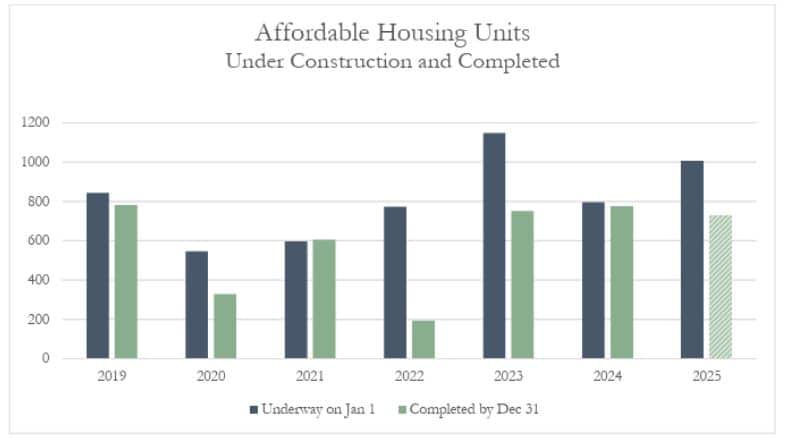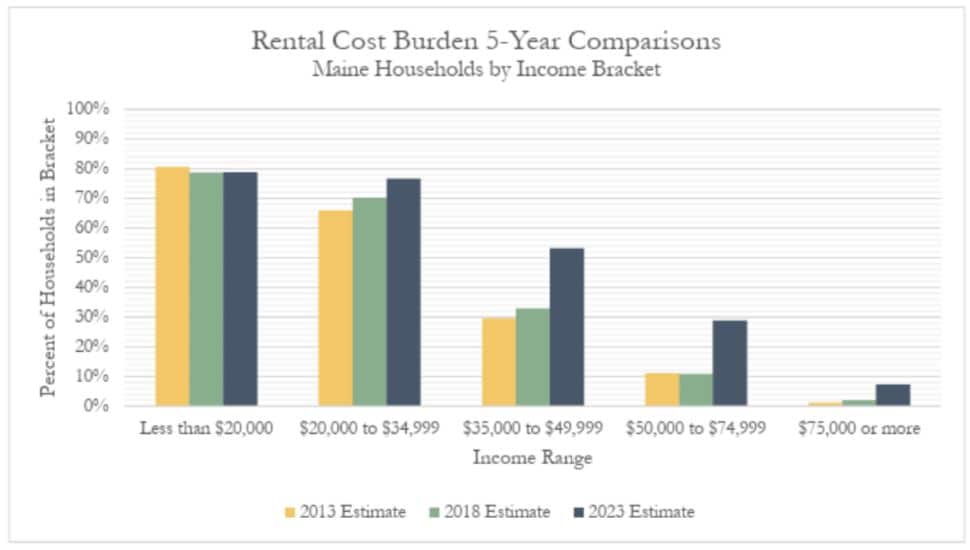Maine’s 2025 Housing Outlook: Silver Linings Amidst Warning Signs
Despite Progress on Homelessness and Supply, the Pine Tree State is Growing Less Affordable

By Ethan Finlan
5 min read
In February, Maine’s State Housing Authority released its first annual assessment of housing affordability in the Pine Tree State. The 2025 Housing Outlook finds both positive and negative signs for the affordable housing market. Notably, price growth and homelessness slowed in 2024, and hundreds of units are coming online in 2025. But home prices still outpaced wage growth, and more Mainers are struggling to cover home costs than in 2023. MaineHousing hopes these reports will help the state keep track of such situations and identify solutions.
The goal of annual tracking is to summarize the state’s data about its housing market rather than to anticipate any particular outcome. “The purpose of this report is to provide data and perspective to inform expectations for the coming year, not to make predictions,” Jonny Kurzfeld, the organization’s research and planning director, says in a press release. The authority intends to release such reports every January. The Outlook focuses on four key aspects of the housing market: affordability, production, homeownership, and homelessness.
On the positive side, the report finds that affordable housing production is on an upward trend. As of January, 1,005 affordable units were being built, and 727 of those will open this year. The report notes that production spiked throughout the Northeast by around 50 percent. In turn, Maine’s construction employment rose just over seven percent relative to 2023. In another sign of housing market health, foreclosure rates have stayed, on average, 40 percent below pre-pandemic levels since Summer 2022.
“Assuming bipartisan support and funding for affordable housing development remains steady,” the authors state, “MaineHousing expects to continue increasing Maine’s affordable housing supply at this steady pace.” In recent years, the state has made moves to increase the housing supply, including allocating tens of millions in tax credits and passing deregulatory laws preempting municipal zoning to allow additional units to be built.
Market rate mortgages have dipped following increases in 2022, and the authority maintains substantially lower rates. “MaineHousing’s First Home programs have steadily continued to create homeownership opportunities for first-time buyers,” the report states. It also points to stabilizing heating costs as a positive sign for affordability. The program assists low-income earners in making down payments and closing expenses.
On homelessness, the Outlook studies numbers of homeless Mainers, as well as length of shelter stays, along with how often people “return to homelessness” after staying in supportive housing. Last year, the number of individuals requiring homelessness services after leaving them dropped; evictions also declined.
The report expresses optimism about the fundamentals behind affordable housing in Maine, pointing to positive nationwide and state-level economic indicators. But it also observes the challenges that weigh on housing affordability.
For one, production challenges loom. While the supply chain situation has improved relative to the pandemic-era crisis point and wage growth has moderated, builders still face lag times in receiving materials, forcing them to change strategies. And there are policy-related headwinds: In addition to the impact of potential tariff increases, the report highlights the Build America, Buy America Act as a source of upward material price pressure. The policy, implemented in 2021, impacts any federally financed infrastructure initiative.
The overall picture for housing affordability in the 2020s is also concerning. “From 2020 to 2024, the median home price in Maine grew by more than 50 percent,” the report notes, “while the wages and salaries of Maine workers grew by less than 33.3 percent.”
Among low-income earners in the state, the “cost burdened” rate—defined as individuals spending 30 percent or more of their gross income on housing expenses—has grown. Through the 2010s and 2020s, the number of Maine renters earning between $20,000 and $34,9999 who are cost burdened rose almost nine percent, and nearly 20 percent amongst the next tier up in five years alone. This reflects a Redfin analysis finding that a Maine minimum wage earner needs to work a 105-hour work week to afford an apartment. In higher income tiers, the cost burdened share has also shot up, with nearly 29 percent of Mainers earning between $50,000 and $74,999 annually qualifying now compared to 10.8 percent in 2019.
And while homelessness returns are dropping, the return to homelessness rate grew 38 percent in 2024, prompting concern about more competition for scarce affordable homes and the sustainability of homelessness prevention efforts.
These findings reflect another recent report conducted by the Maine Policy Institute (MPI). Analysis found that Maine’s average home price was $400,000, and blamed restrictive zoning policies on the municipal level that prevent builders from meeting market demand.
“[S]ince 2020…zoned towns have permitted 9.06 fewer total units, 1.95 more single-family units, and 11.01 fewer multifamily units than unzoned towns,” MPI wrote. “Between 2010 and 2024, Maine’s population grew by over 70,000 people, however, we have not had housing growth at the same rate.”
Maine’s Outlook report contains data that can prove useful to both policymakers and the affordable housing industry. While many of the trends reflect the market’s national direction, it provides the ability to track trends on a local level and thus the effectiveness of programs, such as the state’s homelessness services and subsidies for lower-income homebuyers.





